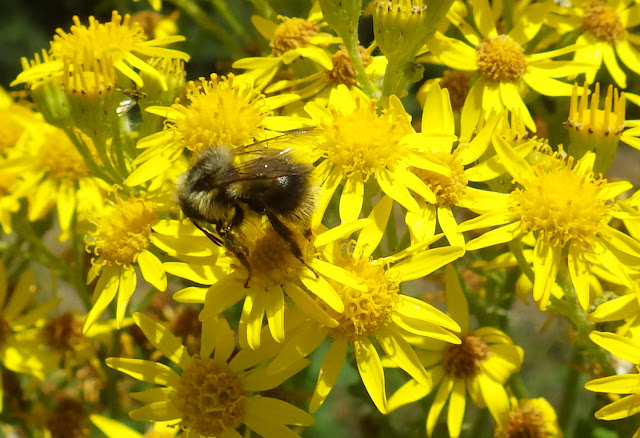On the road between UBC Farm and the UBC Botanical Garden I searched for bees in the roadside weeds.
This little guy in the mallow has a fabulous mustache.
He was still a little sleepy, so let's leave him dream in peace.
The last blackberry blossoms were full of a variety of bees.
I don't know what this flower is, but the bumblebees love it.
Here's the 49 bus stop by the Botanical Garden. I actually don't recommend you walk here because it's highly dangerous--too close to traffic.
Once inside the garden, I head to my favorite spot, which is the series of xeriscape beds on the east side.
This plant called Berkheya cirsiifolia, which looks like a thistle that mated with a cactus, was a hot spot for interesting bees. And I mean that literally. Look at the way the plant turns to the sun and catches the midday heat.
The lush stamens attract this large leafcutter with the orange hairs on the underside of its abdomen.
And this beautiful melissodes with its hairy pollen-collecting chaps.
Trust the agapostemon to find the best stamens on display.
This nearby plant was attracting honeybees and the little melissodes.
Look at how much pollen this little bee is packing on her legs! These little bees have a squat square gestalt when you look at them from above.
I love this combination of plants.
Andrena prunorum adores rattlesnake master.
The silver linden is just about bloomed out.
Here is some swamp verbena (Verbena hastata) in all its glory.
This is the first time I've seen a frog in a long while. The kids were having a blast here at the pond, spotting tadpoles. They named this one "Cedric". He looks like a Cedric!
Many of the tadpoles had legs, like this one.
Thirsty honeybees were sipping water at the edge of the pond. They can take this liquid back to help cool down the hive.
This shrub has flowers with lovely stamens loved by wee bees.
In the Physic Garden a leafcutter was diving right into those luscious artichoke flowers.
I know it's projection, but foraging leafcutters seem to embody joy.
The wool carder bees were monopolizing the motherwort. I wonder if the females harvest the furs on the flowers. Let me know if you see them doing that.
A very shiny fly suns itself in the food garden.
It's lovely to see this milkweed, but I wouldn't put it in the food garden because it's highly toxic.
This is the wildflower mix I'd recommend from West Coast Seeds: the alternative lawn mix. Here it is attracting a wide variety of small bees I'm not seeing anywhere else in the garden. It's magical. I'm so glad I've given out bags and bags of these seeds.
This was my most exciting find of the day. I think it's a tiny male melissodes bee. Look at those long antennae!
It's good to know you can easily tuck this low growing seed mix into a raised garden bed.
Hello heliopsis!
I didn't see many species of bumblebees. This is an eastern bumblebee escaped from greenhouse agriculture, and implicated in the collapse of native bumblebee species.
Whoa, that's a lot of beehives. This will also adversely affect the biodiversity and number of native bees in the gardens.
If you're going to have honeybees, you're going to need a few acres of this anise hyssop.
After leaving the garden to walk to the bus stop I saw this sweetie in a lovely grouping of pink potentilla.
Hopefully this will help you spot a few bees on your own tour of the UBC Botanical Garden. I'd love to see some folks with really good macro skillz to take photos of these bees.





















































No comments:
Post a Comment